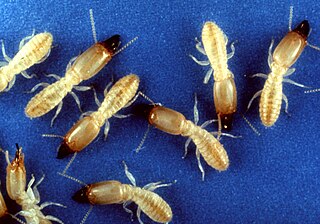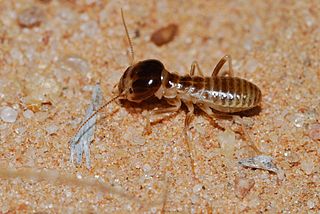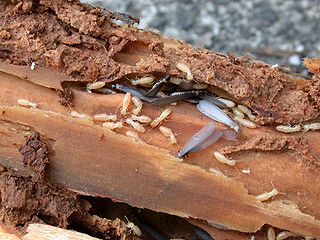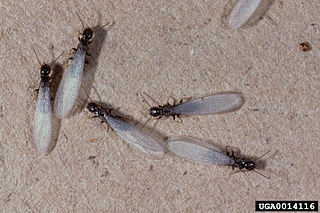Related Research Articles

Termites are a group of detritophagous eusocial insects which consume a wide variety of decaying plant material, generally in the form of wood, leaf litter, and soil humus. They are distinguished by their moniliform antennae and the soft-bodied and often unpigmented worker caste for which they have been commonly termed "white ants"; however, they are not ants, to which they are distantly related. About 2,972 extant species are currently described, 2,105 of which are members of the family Termitidae.

The Formosan termite is a species of termite local to southern China and introduced to Taiwan, Japan, South Africa, Sri Lanka, Hawaii, and the continental United States.

Blattodea is an order of insects that contains cockroaches and termites. Formerly, termites were considered a separate order, Isoptera, but genetic and molecular evidence suggests they evolved from within the cockroach lineage, cladistically making them cockroaches as well. The Blattodea and the mantis are now all considered part of the superorder Dictyoptera. Blattodea includes approximately 4,400 species of cockroach in almost 500 genera, and about 3,000 species of termite in around 300 genera.

Reticulitermes flavipes, the eastern subterranean termite, is the most common termite found in North America. These termites are the most economically important wood destroying insects in the United States and are classified as pests. They feed on cellulose material such as the structural wood in buildings, wooden fixtures, paper, books, and cotton. A mature colony can range from 20,000 workers to as high as 5 million workers and the primary queen of the colony lays 5,000 to 10,000 eggs per year to add to this total.

Amitermitinae is a disputed subfamily of "higher termites" now often merged with the subfamily Termitinae and is considered by ITIS as a synonym; it had previously been placed in the family Rhinotermitidae.

Mastotermes darwiniensis, common names giant northern termite and Darwin termite, is a termite species found only in northern Australia. It is the most primitive extant termite species. Contrary to common belief, this species does not form mounds as the nests are subterranean and inconspicuous. Colonies will readily occupy and infest decomposing wood but primarily live in a complex subterranean network of tunnels and galleries which they use to travel to new food sites. Colonies may eventually split and form isolated satellite colonies.

Coptotermes gestroi, commonly known as the Asian subterranean termite is a small species of termite that lives underground. Both this species and the Formosan subterranean termite are destructive pests native to Asia, but have spread to other parts of the world including the United States. In Asia, this species is known as the Philippine milk termite.

The Hodotermitidae are a basal Old World family of termites known as the harvester termites. They are distinguished by the serrated inner edge of their mandibles, and their functional compound eyes which are present in all castes. They forage for grass at night and during daylight hours, and the pigmented workers are often observed outside the nest. Their range includes the deserts and savannas of Africa, the Middle East, and Southwest Asia. Their English name refers to their habit of collecting grass, which is not unique to the family however.

Reticulitermes is a termite genus in the family Rhinotermitidae. They are found in most temperate regions on Earth including much of Asia and the Middle East, Western Europe, and all of North America.

Incisitermes minor is a species of termite in the family Kalotermitidae known commonly as the western drywood termite. It is native to western North America, including the western United States and northern Mexico. It has been found in many other parts of the United States, all the way to the East Coast. It has been reported from Toronto. It has been introduced to Hawaii. It has been noted in China and it is not uncommon in Japan. This is an economically important pest of wooden structures, including houses. In California and Arizona alone its economic impact is estimated to be about $250 million per year.

Coptotermes is a genus of termites in the family Rhinotermitidae. Many of the roughly 71 species are economically destructive pests. The genus is thought to have originated in Southeast Asia. Worker termites from this genus forage underground and move about in roofed tunnels that they build along the surface.

Coptotermes acinaciformis is a species of subterranean termite in the family Rhinotermitidae native to Australia. Termites are social insects and build a communal nest. In the case of C. acinaciformis, this is either in the root crown of a tree or underground. From this, a network of galleries extends through the nearby soil, enabling the workers to forage in the surrounding area without emerging on the surface of the ground. This termite can cause substantial damage to trees and the wooden parts of buildings.
Heterotermes indicola, is a species of subterranean termite of the genus Heterotermes. It is native to tropical India, Pakistan and Sri Lanka but has extended its range into the subtropics and warm temperate areas of the Himalayan foothills to altitudes of about 2,000 m (6,600 ft). It causes damage to timber in buildings and is one of the most destructive termites in urban and agricultural areas in the world. Soldiers are about 4.1-4.9mm long. Extracts of garlic and Calotropis procera are known to have termiticidal effects on H. indicola.

Gnathamitermes perplexus, the long-jawed desert termites or tube-building termites, is a species of termite in the family Termitidae. It is found in Central America and North America. The species creates tunnels, with both colony founders and workers transporting sand to excavate tunnels using their mandibles. The species is particularly susceptible to infectious nematodes such as Steinernema riobrave.
Prorhinotermes simplex, the Cuban subterranean termite, is a species of lower termite in the genus Prorhinotermes. It is found in Colombia. Like others in its genus, it is a single-site nesting termite that moves to a new food source when theirs is gone, and it lacks a true worker caste.

Reticulitermes speratus, the Japanese termite, is a species of subterranean termite found in Japan, North Korea, and South Korea. It eats decayed wood. It is adapted to withstand the cold temperatures of the temperate regions it inhabits.

Reticulitermes virginicus is a species of subterranean termite native to North America, found often in the southern United States. It was described in 1907.

Reticulitermes tibialis, the arid-land subterranean termite, is a species of termite in the family Rhinotermitidae. It is found in the United States, mostly in the western half, occurring in deserts, prairies and other dry locations.
Coptotermes heimi is a species of termite in the family Rhinotermitidae. It is found in India, Pakistan and Bangladesh and lives wholly underground.
Heterotermes aureus, commonly known as the desert subterranean termite, is a species of termite in the family Rhinotermitidae. It is native to the deserts of North America where the colony has an underground nest.
References
- 1 2 "Termite Baits: A Guide for Homeowners" . Retrieved 2013-04-30.
- 1 2 "Above Ground Termite Baiting. Florida Entomologist 82(1), March 1999, pg. 60" (PDF). Retrieved 2015-04-06.
- ↑ "Termite Behavior" . Retrieved 2014-12-15.
- ↑ "How Termites Work" . Retrieved 2013-06-14.
- ↑ "Termite Treatment". Saturday, 19 January 2019
- ↑ Michael Potter, Consumer Update: Termite Baits, U. of Kentucky college of Agriculture https://www.uky.edu/Ag/Entomology/entfacts/struct/ef644.htm
- ↑ "Presidential Green Chemistry Challenge: 2000 Designing Greener Chemicals Award" . Retrieved 2023-02-15.
- ↑ "Termite Colony Elimination System: Termite Control Without Using Toxic Insecticides" . Retrieved 2023-02-15.
- ↑ "Large-scale Suppression of a Subterranean Termite Community Using the Sentricon Termite Colony Elimination System: A Case Study in Chatsworth, California, USA" (PDF). Retrieved 2023-02-15.
- ↑ "UF study shows why termite bait works and how scientists can improve it" . Retrieved 2023-02-15.
- ↑ Eger, J. E.; Lees, M. D.; Neese, P. A.; Atkinson, T. H.; Thoms, E. M.; Messenger, M. T.; Demark, J. J.; Lee, L.-C.; Vargo, E. L.; Tolley, M. P. (2012). "Elimination of Subterranean Termite (Isoptera: Rhinotermitidae) Colonies using a Refined Cellulose Bait Matrix Containing Noviflumuron When Monitored and Replenished Quarterly". Journal of Economic Entomology. 105 (2): 533–539. doi:10.1603/EC11027. PMID 22606824. S2CID 8255685 . Retrieved 2015-04-06.
- ↑ "Response of Reticulitermes spp. (Isoptera: Rhinotermitidae) in northern California to baiting with hexaflumuron with sentricon termite colony elimination system" . Retrieved 2015-04-06.
- ↑ "The Statue of Liberty". Hassman Termite. Retrieved 2022-06-07.